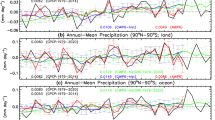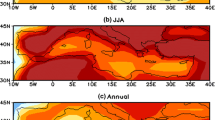Abstract
During the post-1979 period in which the satellite-based precipitation measurements with global coverage are available, global mean surface temperature rapidly increased up to late 1990s, followed by a period of temperature hiatus after about 1998/1999. Comparing observed surface temperature trends against the simulated ones by the CMIP5 historical experiments especially in the zonal mean context suggests that although the anthropogenic greenhouse-gases (GHG) forcing has played a major role, in addition to the anthropogenic aerosols and various natural forcings, the effects from decadal-to-interdecadal-scale internal modes specifically the Pacific Decadal Oscillation (PDO) are also very strong. Evident temperature changes associated with the PDO’s phase shift are seen in the Pacific basin, with decadal-scale cooling in the tropical central-eastern Pacific and most of the east basin and concurrent warming in the subtropics of both hemispheres, even though the PDO’s net effect on global mean temperature is relatively weak. The Atlantic Multidecadal Oscillation (AMO) also changed its phase in the mid-1990s, and hence its possible impact is estimated and assessed as well. However, comparisons with CMIP5 simulations suggest that the AMO may have not contributed as significantly as the PDO in terms of the changes/trends in global surface temperature, even though the data analysis technique used here suggests otherwise. Long-term precipitation changes or trends during the post-1979 period are further shown to have been modulated by the two major factors: anthropogenic GHG and PDO, in addition to the relatively weak effects from aerosols and natural forcings. The spatial patterns of observed precipitation trends in the Pacific, including reductions in the tropical central-eastern Pacific and increases in the tropical western Pacific and along the South Pacific Convergence Zone, manifest the PDO’s contributions. Removing the PDO effect from the total precipitation trends makes the spatial structures of precipitation trends more similar to those simulated by CMIP5 historical full forcing experiments particularly in the context of zonal-mean results. This also confirms that in spite of the PDO effect specifically on regional scales, the anthropogenic GHG signals are still discernible in observed precipitation during the time period. Following the increase of GHG, precipitation tends to increase roughly along the climatological ITCZ and decrease south of the equator and in the subtropics of both hemispheres.







Similar content being viewed by others
References
Adler RF, Huffman GJ, Chang A, Ferraro R, Xie P, Janowiak J, Rudolf B, Schneider U, Curtis S, Bolvin D, Gruber A, Susskind J, Arkin P (2003) The version 2 global precipitation climatology project (GPCP) monthly precipitation analysis (1979-present). J Hydrometeor 4:1147–1167
Adler RF, Gu G, Wang J-J, Huffman GJ, Curtis S, Bolvin D (2008) Relationships between global precipitation and surface temperature on the longer-than-seasonal time scales (1979–2006). J Geophys Res Atmos 113:D22104. doi:10.1029/2008JD010536
Allan RP, Liu C, Zahn M, Lavers DA, Koukouvagias E, Bodas-Salcedo A (2013) Physically consistent responses of the global atmospherid hydrological cycle in models and observations. Geophys Surv. doi:10.1007/s10712-012-9213-z
Allen MR, Ingram WJ (2002) Constraints on future changes in climate and the hydrologic cycle. Nature 419:224–232
Bretherton CS, Widmann M, Dymnikov VP, Wallace JM, Blade I (1999) The effective number of spatial degrees of freedom of a time-varying field. J Clim 12:1990–2009
Burgman RJ, Clement AC, Mitas CM, Chen J, Esslinger K (2008) Evidence for atmospheric variability over the Pacific on decadal timescales. Geophys Res Lett 35:L01704. doi:10.1029/2007GL031830
Deser C, Phillips AS, Hurrell JW (2004) Pacific interdecadal climate variability: linkage between the tropics and the North Pacific during boreal winter since 1900. J Clim 17:3109–3124
Dong B, Sutton RT, Scaife AA (2006) Multidecadal modulation of El Niño-Southern Oscillation (ENSO) variance by Atlantic Ocean sea surface temperature. Geophys Res Lett 33:L08705. doi:10.1029/2006GL025766
Enfield DB, Mestas-Nuñez AM, Trimble PJ (2001) The Atlantic multidecadal oscillation and its relation to rainfall and river flows in the continental U.S. Geophys Res Lett 28:2077–2080
Friedman AR, Hwang Y-T, Chiang JCH, Frierson DMW (2013) Interhemispheric temperature asymmetry over the twentieth century and in future projections. J Clim 26:5419–5433
Gu G, Adler RF (2013) Interdecadal variability/long-term changes in global precipitation patterns during the past three decades: global warming and/or Pacific decadal variability? Clim Dyn 40:3009–3022. doi:10.1007/s00382-012-1443-8
Gu G, Adler RF, Huffman G, Curtis S (2007) Tropical rainfall variability on interannual-to-interdecadal/longer-time scales derived from the GPCP monthly product. J Clim 20:4033–4046
Hansen J, Ruedy R, Glascoe J, Sato M (1999) GISS analysis of surface temperature change. J Geophys Res 104:30997–31022
Hansen J et al (2007) Climate simulations for 1880–2003 with GISS model E. Clim Dyn 29:661–696
Held IM, Soden BJ (2006) Robust responses of the hydrological cycle to global warming. J Clim 19:5686–5699
Huffman GJ, Adler RF, Bolvin DT, Gu G (2009) Improvements in the GPCP global precipitation record: GPCP version 2.1. Geophys Res Lett 36:L17808. doi:10.1029/2009GL040000
John VO, Allan RP, Soden BJ (2009) How robust are observed and simulated precipitation responses to tropical ocean warming? Geophys Res Lett 36:L14702. doi:10.1029/2009GL038276
Knight JR, Folland CK, Scaife AA (2006) Climate impacts of the Atlantic multidecadal oscillation. Geophys Res Lett 33:L17706. doi:10.1029/2006GL026242
Kosaka Y, Xie S-P (2013) Recent global-warming hiatus tied to equatorial Pacific surface cooling. Nature. doi:10.1038/nature12534
Lu R, Dong B, Ding H (2006) Impact of the Atlantic multidecadal oscillation on the Asian summer monsoon. Geophys Res Lett 33:L24701. doi:10.1029/2006GL027655
Mantua NJ, Hare SR (2002) The Pacific decadal oscillation. J Ocean 58:35–44
Meehl GA, Arblaster JM, Fasullo JT, Hu A, Trenberth KE (2011) Model-based evidence of deep-ocean heat uptake during surface-temperature hiatus periods. Nat Clim Change 1:360–364. doi:10.1038/nclimate1229
Meehl GA, Hu A, Arblaster JM, Fasullo J, Trenberth KE (2013) Externally forced and internally generated decadal climate variability associated with the interdecadal Pacific oscillation. J Clim 26:7298–7310
Muller RA, Curry J, Groom D, Jacobsen R, Perlmutter S, Rohde R, Rosenfeld A, Wickham CW, Wurtele J (2013) Decadal variations in the global atmospheric land temperature. J Geophys Res 118:5280–5286
Semenov VA, Latif M, Dommenget D, Keenlyside NS, Strehz A, Martin T, Park W (2010) The impact of North Atlantic-Artic multidecadal variability on northern hemisphere surface air temperature. J Clim 23:5668–5677
Smith TM, Reynolds RW, Peterson TC, Lawrimore J (2008) Improvements to NOAA’s historical merged land–ocean surface temperature analysis (1880–2006). J Clim 21:2283–2296
Taylor KE, Stouffer RJ, Meehl G (2012) An overview of CMIP5 and the experiment design. Bull Am Meteorol Soc 93:485–498. doi:10.1175/BAMS-D-11-00094.1
Thompson DWJ, Wallace JM, Hegerl GC (2000) Annular modes in the extratropical circulation. Part II: trends. J Clim 13:1018–1036
Trenberth KE, Fasullo JT (2013) An apparent hiatus in global warming? Earth’s Future. doi:10.1002/2013EF000165
Tung K-K, Zhou J (2013) Using data to attribute episodes of warming and cooling in instrumental records. Proc Natl Acad Sci USA 110:2058–2063
Wentz FJ, Ricciardulli L, Hilburn K, Mears C (2007) How much more rain will global warming being? Science 317:233–235
Wilcox LJ, Highwood EJ, Dunstone NJ (2013) The influence of anthropogenic aerosol on multi-decadal variations of historical global climate. Environ Res Lett. doi:10.1088/1748-9326/8/2/024033
Wu S, Liu Z, Zhang R, Delworth TL (2011a) On the observed relationship between the Pacific decadal oscillation and the Atlantic multi-decadal oscillation. J Oceanogr 67:27–35
Wu Z, Huang NE, Wallace JM, Smoliak BV, Chen X (2011b) On the time-varying trend in global-mean surface temperature. Clim Dyn 37:759–773
Xue Y, Smith TM, Reynolds RW (2003) Interdecadal changes of 30-year SST normals during 1871–2000. J Clim 16:1601–1612
Zhang R, Delworth TL (2007) Impact of the Atlantic multidecadal oscillation on North Pacific climate variability. Geophys Res Lett 34:L23708. doi:10.1029/2007GL031601
Zhang Y, Wallace JM, Battisti DS (1997) ENSO-like interdecadal variability: 1900–1993. J Clim 10:1004–1020
Zhang R, Delworth TL, Held IM (2007) Can the Atlantic Ocean drive the observed multidecadal variability in Northern Hemisphere mean temperature? Geophys Res Lett 34:L02709. doi:10.1029/2006GL028683
Acknowledgments
The NASA-GISS global surface temperature anomaly product was downloaded from its website at http://data.giss.nasa.gov/. The ERSST data set (v3b) was downloaded from the NOAA-NCDC website at http://www.ncdc.noaa.gov/ersst/. The historical simulations from multiple CMIP5 models and the AMIP precipitation outputs of NASA/GISS Model E were downloaded from the CMIP5 website (http://cmip-pcmdi.llnl.gov/index.html). We acknowledge the World Climate Research Programme’s Working Group on Coupled Modelling and the U.S. Department of Energy’s Program for Climate Model Diagnosis and Intercomparison. This research is supported under the NASA Modeling, Analysis, and Prediction (MAP) Programs and the NASA Energy and Water-cycle Study (NEWS).
Author information
Authors and Affiliations
Corresponding author
Rights and permissions
About this article
Cite this article
Gu, G., Adler, R.F. & Huffman, G.J. Long-term changes/trends in surface temperature and precipitation during the satellite era (1979–2012). Clim Dyn 46, 1091–1105 (2016). https://doi.org/10.1007/s00382-015-2634-x
Received:
Accepted:
Published:
Issue Date:
DOI: https://doi.org/10.1007/s00382-015-2634-x




